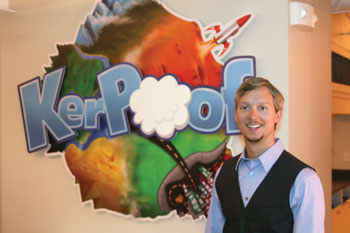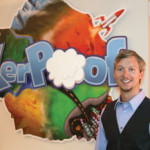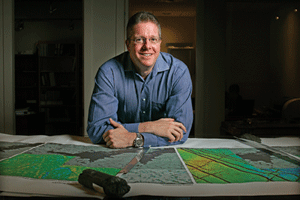
Tom Fischaber at Disney Online Kerpoof Studios, where four Mines graduates currently work (Jeff Ward ’05, Raul Rangel ’08, MS ’09, Richie Zirbes ’10, MS ’12 and Janeen Neri ’11). The company is also employing a Mines student intern this summer.
Tom Fischaber ’98 can recall the precise day his new Internet venture achieved critical mass. It was September 18, 2007, and his company, Kerpoof, was one of 40 startups invited by TechCrunch, a leading technology blog, to present at its inaugural conference. Unlike most conferences, TechCrunch 40, as it was called, was not charging presenters a hefty fee. “That was important,” says Fischaber, with a chuckle.
He and three co-founders had launched the Boulder, Colo.-based Kerpoof 18 months earlier with $50,000 of their own money and a commitment to take no salaries for a year. The four had been engineers at Xilinx, a programmable-chip maker in Longmont, Colo., where Fischaber worked for eight years as a designer in its intellectual property division, developing numerous high-speed networking products for which he was granted seven U.S. patents.
Fischaber majored in electrical engineering at Mines alongside his twin brother, Curtis ’98, and both joined Xilinx after graduation. Curtis, who shares Tom’s DNA but not the entrepreneurial itch, chose to remain at Xilinx, where he is a staff engineer in the company’s design center. Their younger brother, Scott ’03, also majored in electrical engineering at Mines and pledged to Sigma Phi Epsilon, which makes the three fraternity brothers as well. Today, Scott is the co-founder and chief engineering officer at CapnaDSP, a technology company in Belfast, U.K.
Fischaber says Kerpoof began with a mission to create a space on the Internet where kids could find fun that was both creative and educational. “We thought the children’s market was underserved,” he says. “We thought we could do something unique.” The company’s first offering, Make a Picture, allowed kids to select a background, place objects in it, move them around for a change in perspective, and add color.
While their team is strong in engineering know-how and creativity, Fischaber admits they lacked marketing savvy. “We took the engineers approach: ‘If you build it, they will come,’” he recalls. “We built a wonderful website, and they didn’t come. Nobody knew about it.”
However, things changed when the company won two National Science Foundation grants totaling $150,000 for an idea that taught kids how to program through animation. The funding kept the company afloat, and they were able to develop a new product, Make a Movie, which Kerpoof introduced at TechCrunch 40.
Fischaber ran the visuals on the big screen while his partner, Krista Marks, outlined the company’s vision of a website where kids not only see great art, but they create it. Where kids not only read great stories, but they write and illustrate them. Where kids not only watch movies, but they make them. Then they showed a brief animation created by an 11-year-old girl in 20 minutes on her first try. There were audible cries of ‘Wow!’ from the audience of venture capitalists and high-tech bigwigs. The buzz that followed brought them enough publicity that, almost overnight, they had users in more than 20 countries, says Fischaber.
Among those wowed at TechCrunch 40 was a small group from Disney, who saw this as an exciting new way to reach kids. Within a year, Disney had acquired Kerpoof, renaming it Disney Online Kerpoof Studios, and its marketing and financial challenges disappeared.
“We didn’t start the company to sell it,” says Fischaber, “but Disney was the best possible win. It’s a company with great integrity, and no other company has better brand alignment and reach with children’s creativity than Disney.” Moreover, Disney wanted the founders to stay on and continue expanding the company, which they did, often recruiting Mines graduates, as they had at Xilinx.
Three and a half years later, Disney Online still has a strong presence in Boulder. Not only does Kerpoof.com continue to flourish as a top site for creativity in the classroom, but the team also has developed Disney.com/Create, where more than 10 million pieces of art have been created and they’ve logged 100 million views.
Ready for new opportunities, the Kerpoof founders have now gone their separate ways. Fischaber left in January and is taking time off to travel with his fiancee before their wedding in August. Speaking from Paris, where we caught up with him for a phone interview in May, Fischaber says the entrepreneurial itch is still there for him, but he’s not thinking about launching a new company right now: “I’m focusing on getting married.”





These Miners took a great formal education, mixed some new ideas and produced a valuable product. I’m sure they had a vision from the start and mile stones to measure their success. It really is not that hard when you trust your intuition and dreams. The universe rewards those who try like Colorado Mines Student do.
I imagine being close to each other was a big plus. I also believe that success comes from keeping your eye on your goal like Mines Graduate must do.
My Congratulation to them for doing what they wanted to do.
Lee Bovey Geol. Engr. “57
Certified Life Coach